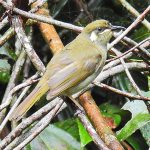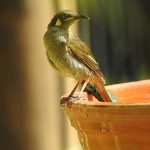CRYPTIC HONEYEATER
The Cryptic Honeyeater is a small, subtly coloured bird that often blends seamlessly into its surroundings. It sports a muted palette of olive and grey, with a slightly lighter underbelly. Its plumage is designed for camouflage, allowing it to move quietly through the foliage. Its slender bill is perfectly adapted for its feeding habits, which we’ll explore shortly.
This honeyeater is primarily found in the tropical and subtropical rainforests of nort-heastern Queensland. It thrives in dense, moist environments where it can easily hide among the leaves. These rainforests offer the perfect combination of food and shelter, making them ideal for the Cryptic Honeyeater’s lifestyle.
As its name suggests, the Cryptic Honeyeater primarily feeds on nectar. It plays a crucial role in pollination as it flits from flower to flower, sipping the sweet nectar with its specialised tongue. By feeding on nectar, the Cryptic Honeyeater assists in the pollination of various native plant species, highlighting its importance in the ecosystem. However, it is not strictly a nectarivore; it also consumes small insects and spiders, which provide essential proteins and nutrients.
The breeding season for the Cryptic Honeyeater typically aligns with the availability of food, often during the wetter months when flowers are abundant. The female usually constructs a small, cup-shaped nest hidden amongst dense foliage. She lays a clutch of two to three eggs, which she incubates herself. The male assists by bringing food to the nest, ensuring the young have the best chance of survival.
While specific data on their lifespan is limited, many small birds of similar size tend to live for about 5 to 10 years in the wild, depending on environmental conditions and predation pressures.
As its name implies, the Cryptic Honeyeater is not easily spotted. Birdwatchers often rely on its distinctive calls to locate it within the dense rainforest where it is known for its soft, melodic calls. These calls are often described as a series of gentle whistles and trills, which can be heard echoing through the rainforest. Their vocalisations play a vital role in communication between mates and establishing territory.
Its ability to thrive in dense rainforest environments showcases its adaptability and the intricate balance of Australia’s ecosystems.
The Cryptic Honeyeater is a wonderful example of nature’s subtle beauty and the intricate relationships between flora and fauna. Its role in pollination and its elusive nature make it a fascinating subject for both bird enthusiasts and conservationists alike. As we learn more about these remarkable birds, we are reminded of the importance of preserving their habitats to ensure their survival for generations to come.




